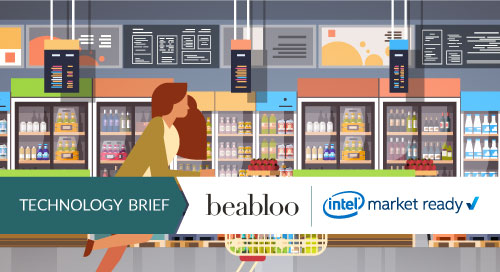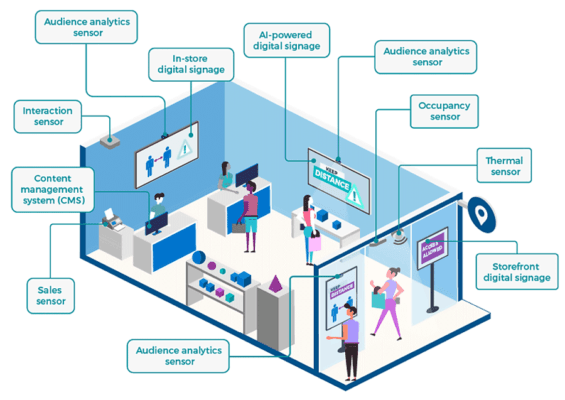AI Powers Profitable and Safe Retail

Today’s retailers gather a wealth of information about online shoppers, and armed with this data, they can target customers with tailored ads to boost sales. But inside brick-and-mortar stores, they are often flying blind.
Computer vision and artificial intelligence (AI) help fill this gap, giving retailers real-time insights about shoppers’ gender, age range, and activities inside the store. The same technology can also be used to keep customers and employees safe in a new global retail environment, today and into the future, all while maintaining personal privacy.
Marketing managers accustomed to delivering targeted online pitches have a hard time developing campaigns for their in-store customers. To solve this problem, Beabloo created the Active Customer Intelligence Suite (ACIS), which uses cameras and other sensors to give retail marketers the customer information they need in real time (Video 1).
Video 1. AI and sensors improve the retail customer experience.
How AI Technology Drives Retail Analytics
The process can start even before customers enter, with a “people counter” sensor mounted on a camera or digital sign at the entrance. The sensor tells retailers how many people are coming into the store and whether they are alone or accompanied by a partner.
Inside the store, cameras and sensors reveal which aisles customers pass through before they buy, where they linger, and where they interact with sales representatives—valuable information that retailers can use to arrange shelving, displays, and staffing for maximum effectiveness (Figure 1).

Thanks to AI-enhanced digital signs and real-time analytics from @beabloo, retailers can give shoppers the personalized experience they’ve come to expect from online shopping.
@insightdottech
Facial detection technology determines customers’ gender and approximate age, allowing retailers to run ads and promotions to the right people at the right times. Information is processed on-site, and the GDPR-compliant system stores no personal data.
Sensor information is relayed to an in-store content management system, where managers see it on a user-friendly dashboard and make real-time decisions about content displays. The campaigns they create can be used on other platforms, such as company websites and social media accounts, with no need for reformatting.
Digital displays engage customers with streaming video and audio messages catering to their demographics and their likely interests. The displays can also be interactive, providing detailed product information to customers who hold up merchandise before a sign.
Stores that already have cameras can easily connect them to Beabloo’s solution with a palm-size but powerful Intel® computer called a NUC, which attaches to cameras and signs. Running on the NUC, the customer intelligence platform analyzes customer information at the edge as it streams in.
Unlike some platforms, Beabloo’s have the ability to coordinate messages with inventory, ensuring that all products advertised are available so that store customers won’t be disappointed. “It’s quite complicated to correlate stock to a campaign, especially for retailers who have thousands of locations selling different products,” says Augusto Modigliani, chief sales and marketing officer at Beabloo.
Retailers can also correlate their messages to time of day, days of the week, physical store location, or even weather forecasts, which all have an influence on retail sales. For example, a store might display ads for sunglasses when it’s hot and switch to umbrellas if a storm approaches.
Digital displays are used not only by merchants selling physical products but by service providers such as banks and travel agencies. AI-embedded signs help them capture the attention of specific customer segments instead of wasting money on generic ads.
A travel agency with multiple outlets was deriving little value from the expensive print ads it displayed in shop windows each month. After the company installed the Beabloo solution, it was able to create real-time campaigns and offers based on the demographics of window-shopping viewers just outside store doors.
“If somebody between 20 and 30 stands in front of the display, it won’t show a cruise, which typically doesn’t interest that age group. Instead, it will show something exciting, such as an adventure trip to Mexico,” Modigliani says. “Targeting the right customers made a big difference to the company’s bottom line. The ads completely changed their business.”
Keeping Employees and Customers Safe
Beabloo’s technology can also be configured to improve health and safety. The company is offering Interaction Care software, which measures human interactions to assure social distancing in physical spaces.
In this way, the people counter helps stores limit entering customers to a level providing for adequate social distancing. Computer-vision cameras determine whether customers are wearing protective masks, and an additional thermal camera senses the presence of fever. Cameras also create “heat maps” showing store managers areas where customers are congregating too closely
The system is not used to point a finger at individuals but to trigger and display messages in problem areas, advising visitors to wear masks and keep appropriate distance.
“Our system is very flexible. The point of our software is to enable retailers to understand customer behavior—the way they move through the store and the way they build their journey,” Modigliani says. “This flexibility also provides a tool for businesses with a physical presence to respond to the new normal with confidence.”
Thanks to AI-enhanced digital signs and real-time analytics, retailers can now give their in-store patrons the kind of personalized experience they have come to expect from online shopping. And just as they do on the internet, smoother customer journeys lead to repeat visits and more sales.